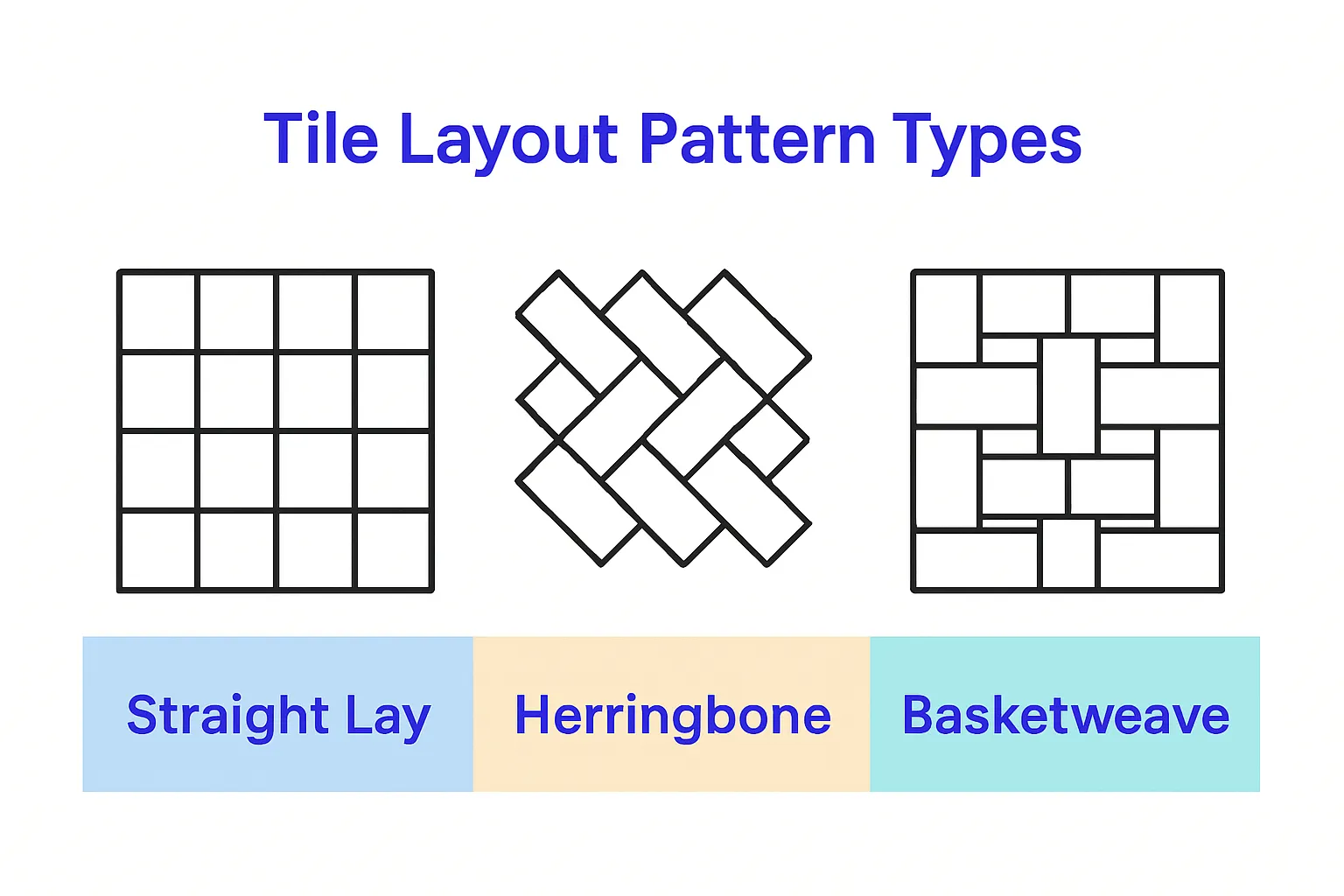Understanding the Role of Tile Layout Patterns
Posted by Mike Belk on Oct 07, 2025

Tile layout patterns do more than cover a floor or wall. They shape entire spaces and set the mood with a few simple lines and angles. You might think a tile is just a tile, but research shows the way you arrange them can actually change how big or small a room feels and even guide where your eyes travel. One study reveals that diagonal tile patterns can make a narrow space seem up to 30 percent wider. Designers use these strategies on purpose, proving your choice of layout is more powerful than you think.
Table of Contents
- What Are Tile Layout Patterns And Their Types?
- The Importance Of Tile Layout Patterns In Design
- How Tile Layout Patterns Affect Space Perception
- Key Concepts Behind Tile Layout Patterns And Aesthetics
- Real-World Applications Of Tile Layout Patterns
Quick Summary
| Takeaway | Explanation |
|---|---|
| Understand tile layout patterns enhance aesthetics | Tile patterns serve as strategic design elements that improve a room’s ambiance and visual appeal. |
| Patterns influence spatial perception and ambiance | Different tile arrangements can visually alter dimensions, making spaces feel larger or more intimate. |
| Choose patterns for emotional and psychological impact | The right tile configuration can evoke specific feelings and guide visual experiences in a space. |
| Consider functionality with aesthetic choices | Tile layouts also address practical concerns like moisture management and structural stability while enhancing design. |
| Cultural significance shapes design choices | Many tile patterns carry cultural meanings, reflecting historical designs and artistic expressions in modern contexts. |
What Are Tile Layout Patterns and Their Types?
Tile layout patterns represent deliberate design strategies that transform ordinary surfaces into visually compelling spaces. These arrangements go beyond simple functional placement, serving as powerful visual tools that can dramatically influence a room’s aesthetic and perceived dimensions. Explore our guide on how tile patterns define your space to understand their transformative potential.
Understanding Basic Tile Layout Concepts
At its core, a tile layout pattern refers to the strategic arrangement of tiles to create visual interest, balance, and flow within a space. These patterns involve precise positioning of individual tiles to generate specific visual effects, ranging from subtle sophistication to bold artistic statements. Professional designers recognize that tile layout patterns are not merely decorative elements but critical design components that can significantly impact a room’s overall ambiance.
The following table summarizes the most common tile layout patterns described in the article along with their key visual effects and how they impact the perception of space.
| Tile Layout Pattern | Description | Visual Effect/Spatial Impact |
|---|---|---|
| Straight Lay | Tiles aligned parallel to walls | Clean, straightforward, creates uniformity |
| Herringbone | Rectangular tiles arranged at 45-degree angles | Dynamic, zigzag effect, adds movement |
| Basketweave | Alternating orientation for a woven texture | Intricate, simulates woven material |
| Diagonal | Tiles set at a diagonal to room walls | Makes narrow spaces up to 30% wider visually |
| Vertical Layout | Tiles oriented vertically | Can make ceilings feel higher |
| Horizontal Layout | Tiles laid along the width of the room | Makes narrow rooms feel wider |
Some fundamental tile layout patterns include:

- Straight Lay: The most basic pattern where tiles are placed parallel to walls, creating a clean and straightforward appearance.
- Herringbone: A dynamic pattern where rectangular tiles are arranged at 45-degree angles, creating a zigzag effect.
- Basketweave: An intricate pattern simulating a woven texture by alternating tile orientations.
Psychological and Spatial Impact of Tile Patterns
Research from Architecture and Design Journal demonstrates that tile layout patterns profoundly influence spatial perception. Different arrangements can make rooms appear larger, smaller, wider, or more elongated. For instance, diagonal patterns can create an illusion of expanded space, while linear horizontal patterns might make a narrow room seem broader.
The role of tile layout patterns extends beyond aesthetic considerations. They serve functional purposes by guiding visual movement, concealing structural imperfections, and creating focal points within interior environments. Professionals carefully select patterns that complement architectural elements, furniture placement, and overall design themes, ensuring a harmonious and intentional visual experience.
The Importance of Tile Layout Patterns in Design
Tile layout patterns represent more than aesthetic choices they are strategic design elements that communicate sophistication and intentionality in architectural spaces. Learn how tile patterns define your interior design strategy to unlock their transformative potential.
Design Aesthetic and Visual Dynamics
Professional designers understand that tile layout patterns serve as powerful visual communication tools. These intricate arrangements can dramatically alter spatial perception, creating impressions of depth, movement, and dimension. By carefully selecting specific tile configurations, designers manipulate visual weight and draw attention to architectural features or create subtle background textures.
Key considerations in tile layout pattern design include:
- Spatial Perception: Patterns can make rooms appear larger or more intimate.
- Visual Flow: Strategic arrangements guide viewers’ visual journey through a space.
- Emotional Response: Different patterns evoke distinct psychological reactions.
Functional and Technical Significance
Beyond aesthetic purposes, tile layout patterns play critical functional roles in architectural design. According to International Design Research Foundation, these configurations impact structural integrity, moisture management, and long-term durability of surface installations.
Technical advantages of sophisticated tile layout patterns include:
- Improved water drainage in wet environments
- Enhanced structural stress distribution
- Minimization of potential installation imperfections
- Increased surface resilience against wear and environmental factors
Professionals approach tile layout patterns as complex design languages that communicate style, functionality, and architectural intelligence.
This table outlines the psychological and functional benefits discussed in the article, showing how thoughtful tile pattern choices go beyond aesthetics to enhance both user experience and structural performance.
| Benefit Type | How Tile Patterns Affect Spaces |
|---|---|
| Spatial Perception | Patterns alter perceived size and flow, make rooms feel larger or more intimate |
| Emotional Response | Specific layouts evoke feelings (serenity, energy, sophistication) |
| Visual Movement | Guide eye flow, highlight features, create focal points |
| Concealment/Correction | Hide irregularities, mask imperfections |
| Structural/Technical Value | Enhance drainage, distribute stress, increase durability |
How Tile Layout Patterns Affect Space Perception
Tile layout patterns possess an extraordinary ability to transform spatial understanding through visual manipulation. These strategic design choices can fundamentally alter how individuals perceive and interact with interior environments. Learn how patterns elevate your home’s aesthetics to appreciate their transformative potential.
Psychological Dimensions of Spatial Perception
The human brain processes visual information through complex neurological pathways that interpret spatial relationships instantaneously. Tile layout patterns leverage these perceptual mechanisms by creating optical illusions that can expand, contract, or redirect visual focus within a space. These subtle visual strategies enable designers to manipulate perceived room dimensions without structural modifications.

Key psychological mechanisms influencing spatial perception include:
- Directional Guidance: Patterns that lead the eye along specific trajectories
- Dimensional Expansion: Configurations that create illusions of broader or more extended spaces
- Visual Rhythm: Repetitive arrangements that establish visual continuity
Geometric Principles and Spatial Transformation
According to Perceptual Neuroscience Research Institute, geometric tile arrangements interact with human visual processing systems to generate nuanced spatial experiences. Diagonal patterns can make narrow rooms appear wider, while vertical layouts can create impressions of increased height. Rectangular tiles positioned longitudinally can elongate spaces, whereas grid-like arrangements provide a sense of stability and containment.
Professional designers strategically deploy tile layout patterns as sophisticated visual tools that transcend mere decorative functions. By understanding the intricate relationship between geometric configurations and human perception, they can craft environments that feel more expansive, intimate, dynamic, or serene depending on specific design objectives. The role of tile layout patterns extends far beyond aesthetic considerations they are powerful instruments of spatial communication and psychological engagement.
Key Concepts Behind Tile Layout Patterns and Aesthetics
Tile layout patterns represent sophisticated design languages that communicate complex visual narratives through geometric arrangements. These intricate configurations transcend simple decorative strategies, functioning as powerful tools for architectural expression. Discover how tile patterns elevate your home’s aesthetic potential to understand their profound design implications.
Geometric Harmony and Visual Language
In architectural design, tile layout patterns operate as a nuanced visual vocabulary where geometric relationships communicate spatial intentions. Each pattern emerges from fundamental mathematical principles that balance symmetry, proportion, and rhythmic repetition. Designers strategically manipulate tile configurations to generate specific emotional and perceptual responses, transforming surfaces from mere functional elements into dynamic aesthetic experiences.
Critical geometric considerations in tile layout design include:
- Symmetrical Balance: Creating visual equilibrium through precise tile placement
- Proportional Relationships: Establishing harmonious scale between tile sizes and room dimensions
- Rhythmic Progression: Developing visual momentum through strategic tile arrangements
Cultural and Historical Context of Tile Patterns
According to Architectural Design Quarterly, tile layout patterns are deeply rooted in cultural traditions, reflecting historical design philosophies and artistic expressions. Different civilizations have developed unique tile configuration techniques that communicate architectural identity, social status, and aesthetic sensibilities.
Traditional tile layout patterns often represent more than decorative choices they are complex visual narratives that encode cultural memory and artistic sophistication. Professional designers recognize these patterns as living design languages that continue evolving, bridging historical craftsmanship with contemporary architectural innovation. By understanding the intricate relationship between geometric configuration, cultural context, and spatial perception, designers transform tile layouts from simple surface coverings into profound aesthetic statements that engage viewers on multiple sensory and intellectual levels.
Real-World Applications of Tile Layout Patterns
Tile layout patterns transcend theoretical design concepts, emerging as practical solutions across diverse professional domains. These strategic configurations solve complex architectural challenges while delivering aesthetic and functional benefits. Explore how tile patterns define your space to understand their comprehensive applications.
Architectural and Environmental Integration
Professional designers leverage tile layout patterns as sophisticated problem-solving tools that address specific environmental and structural requirements. In commercial and residential settings, these patterns manage critical aspects such as moisture control, visual navigation, stress distribution, and spatial perception. By carefully selecting geometric arrangements, architects create surfaces that are not merely decorative but functionally intelligent.
Key architectural applications of tile layout patterns include:
- Moisture Management: Creating strategic drainage pathways in wet environments
- Structural Stress Distribution: Minimizing potential surface fracture points
- Thermal Regulation: Optimizing heat reflection and absorption characteristics
Specialized Sector Applications
According to National Preservation Institute, tile layout patterns play crucial roles in historic preservation, healthcare design, and specialized industrial environments. In medical facilities, specific tile arrangements support hygiene protocols and infection control. Historic restoration projects utilize traditional patterns to maintain architectural authenticity, while industrial spaces employ durable configurations that withstand extreme operational conditions.
Professional practitioners recognize tile layout patterns as dynamic design solutions that bridge aesthetic aspirations with practical performance requirements. By understanding the intricate relationship between geometric configuration and functional performance, designers transform surfaces from passive elements into active contributors to environmental quality, safety, and visual experience.
Bring Your Tile Pattern Vision to Life with BELK Tile
Are you struggling to turn your understanding of tile layout patterns into a real, impactful design for your home or business? You know how much layout, size, and finish can influence the size, flow, and mood of a space. The article highlighted how the right tile pattern can make rooms feel larger, guide the eye, and add unique personality. But the next step is turning that inspiration into a surface that truly reflects your needs and style.
BELK Tile empowers you to do just that. With our unmatched selection of high-quality tiles for every application, you can create any pattern discussed in the article—from classic herringbone to unique basketweave or straight lay. Our user-friendly platform helps you sort by shape, color, material, and décor style, making it easy to find the perfect match. Ready to move from ideas to installation? Visit BELK Tile’s curated collections for inspiration, helpful filters, and competitive pricing on tiles that let you realize your space’s full design potential. Transform your project with the right tile pattern today and see the difference expert design choices can make. Start exploring at BELK Tile now.
Frequently Asked Questions
What are tile layout patterns?
Tile layout patterns are strategic arrangements of tiles designed to create visual interest and enhance the aesthetic of a space. They can influence spatial perception and flow within a room.
How do tile patterns affect spatial perception?
Tile patterns can affect how large or small a room feels by creating optical illusions. For example, diagonal layouts may make narrow spaces appear wider, while straight layouts can give a sense of uniformity.
What are some common types of tile layout patterns?
Common tile layout patterns include Straight Lay, Herringbone, and Basketweave. Each pattern offers a unique visual dynamic and can be used to achieve different design goals.
Why are tile layout patterns important in design?
Tile layout patterns are important as they contribute to both the aesthetics and functionality of a space. They can guide visual movement, hide imperfections, and help communicate a specific style or atmosphere.



